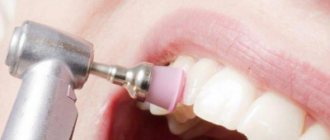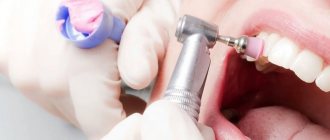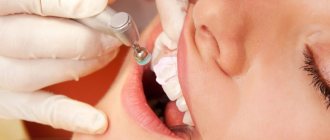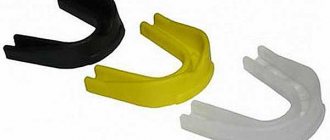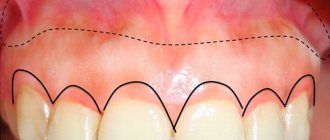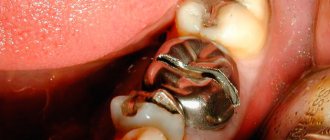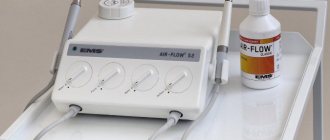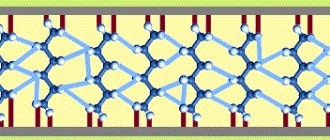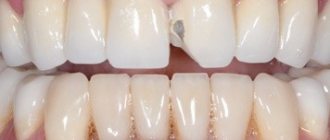Date of publication: 09/28/2018
Tooth filing has been used in dentistry since the 19th century. At that time, the procedure helped treat caries by mechanically removing damaged tissue. Today the technique is used to eliminate other problems, mainly aesthetic ones.
For example, teeth can be filed if one or more units stand out from the general row due to their increased length. Filing can also help with small chips on the edges of the tooth.
In what cases is tooth filing used?
There are different opinions about the advisability of the procedure. It is mainly carried out in the following cases:
- When the upper incisors or canines stand out too much. This not only disrupts aesthetics, but can also interfere with proper bite. In this state of affairs, the teeth can be shortened a little so that they fit better into the dentition.
- If there are small chips on the edges of the teeth. A slight grinding of the enamel will help smooth out the edge.
- If there are sharp corners. Sometimes, due to anatomical features, the front teeth may have protruding parts. They may not look aesthetically pleasing or even damage the cheek.
- For orthodontic bite correction. Sometimes teeth are filed down on the sides to make it easier to move them into the correct position. This is important when installing braces if your teeth are very crowded.
- Filing down the front of the teeth is used when installing veneers. The teeth are also ground down before crowns are installed.
The advisability of filing is determined individually only at the appointment of a specialist.
Cases in which you can straighten teeth without braces
The braces system is the most effective, fastest and painless method for straightening crooked teeth, but many people refuse it for many reasons: they are embarrassed, afraid of discomfort or discomfort associated with eating or while talking.
But there are cases when a person can correct his bite without braces:
- Crooked teeth are only a couple of teeth, not an entire row, so there is no need to wear a complex system;
- The bite only slightly deviates from the norm, but if the bite is open, then braces are still necessary;
- A slight crooked tooth needs to be quickly corrected;
- A person with a “dental” problem is allergic to the metal components that are in braces;
- The gums are located too low, and there is a high probability of injuring them due to the locks of the brace system;
- The patient cannot or does not want to adhere to the rules of wearing and caring for braces;
- The patient wants to look perfect at work or in everyday life, so the use of braces in this case is excluded;
- The patient’s work involves clear and excellent diction (radio DJ, TV presenter, teacher), so he must refuse to wear braces.
Expert opinion
Roman Borisovich Alekperov
orthopedic dentist
Experience: 24 years
If there are indications for filing teeth, it is important to entrust this procedure to an experienced dentist who will correct the aesthetic defect and not cause harm to the teeth. Self-filing is impossible and extremely dangerous - you can seriously damage the tooth, and in the future you will have to resort to microprosthetics or crown prosthetics. There is also a high risk of injury to the mucous membrane and infection.
Symptoms
At first, the disease manifests itself asymptomatically, so it is diagnosed in an advanced state. When tooth enamel is worn away and dentin is involved in the process, patients begin to complain of increased sensitivity. Teeth react to temperature (hot, cold), chemical (sour, sweet), mechanical (touch of a toothbrush) stimuli, causing inconvenience in everyday life.
Dentin destruction leads to root inflammation (periodontitis) and bone tissue atrophy.
The height of the face gradually decreases, pain in the muscles and temporomandibular joint begins. The lower jaw moves upward and backward, the volume of the oropharynx decreases, and less air enters. Problems with the respiratory system begin. The center of gravity shifts, pathological disorders occur in the musculoskeletal system. The quality of life is falling.
How is filing done?
The technology varies depending on the purpose for which the procedure is performed. The process includes a number of steps:
- - Diagnostics. The doctor determines which teeth will be filed and for what purpose. To do this, a visual inspection is carried out, the cause is studied, and the method of performing the procedure is determined.
- — The area in which manipulation is necessary is determined. For this, carbon paper, wax plates, and special aerosols can be used. This helps to highlight or color an area that, for example, prevents the jaws from closing properly. In difficult cases, a plaster model of the jaw can be made.
- If the procedure requires significant removal of hard tissue, anesthesia is performed.
- Sawing is done using a diamond bur. On chewing teeth, a small layer of enamel on the protruding tubercles can be filed away. If we are talking about incisors, the movements are multidirectional and depend on the situation.
- After the procedure, the surface that was manipulated is polished. Also, remineralizing substances can be applied to the surface of the teeth, as well as compositions to strengthen the surface and reduce sensitivity.
When filing teeth, the thickness of the enamel in the treated areas changes. This may cause increased sensitivity. Usually this is a temporary phenomenon and in the first days it is necessary to refrain from eating hot and cold foods so as not to provoke discomfort and pain. If the problem does not go away over time, you should consult a doctor.
Price
The cost of filing teeth depends on the reasons for which it is carried out and what result is needed to achieve:
- preparation for caries - from 200 to 350 rubles per row element;
- treatment of enamel after removing braces – 550-650 rubles;
- identification of traumatic occlusion and grinding of one tooth – 200-300 rubles;
- cutting down a tooth for a crown – 130-200 rubles;
- filing a molar under an orthodontic structure – 150-200 rubles.
Find out how teeth are prepared in the video.
Online consultation with a doctor
If you are interested in questions about teeth filing, you have been prescribed this procedure, but have doubts about its necessity, or are simply concerned about the condition of your teeth, then it is best to undergo an examination and get advice from a dentist. Under no circumstances should you do the filing yourself. A specialist will assess your dental health, listen to complaints and give professional recommendations. Without a competent opinion, you can complicate the situation, which will lead to illness or already have hidden illnesses. Treatment will be more expensive and, in some cases, longer. At the consultation, the vector of your next actions will be set and doubts will be dispelled.
Classification
Teeth abrasion is divided according to:
- Stages
During the active stage, increased abrasion of hard tissue occurs. At the stabilization stage, their condition can be maintained at an acceptable level.
- Distribution
With localized abrasion, the front teeth are most often worn down. In generalized cases, all crowns suffer and the height of the bite decreases. In severe cases, the crown may end right at the gum.
- Shape
With a mixed form, the enamel wears off not only on top, it decreases on all sides. With horizontal, the occlusal surfaces suffer, with vertical, the lateral surfaces.
- Weights:
- Light or 1st degree (within the enamel)
- Transitional or 2nd degree (involving the superficial layers of dentin)
- Pathological or 3rd degree (with exposure of deep layers of dentin)
In grade 1, speech and chewing function are not affected. On the 2nd stage, hypersensitivity and chewing dysfunction appear. On the 3rd, pain in the temporomandibular joint begins. They radiate to the neck and head and can lead to hearing loss and decreased vision.
Restoration and normalization of the dental system
These tasks are implemented during orthodontic treatment. The correct position of the teeth and physiological bite not only improve the aesthetic function of the oral cavity, but also contribute to the uniform distribution of the load on the teeth. To achieve such results, orthodontic appliances are used, which can be removable or non-removable. In the first case, the Dahl method is used, the essence of which is that a pre-made bite pad is installed on the inner surface of the front teeth, which is necessary for uniform distribution of pressure vertically. The platform is fixed with clasps to the supporting teeth (usually canines and premolars); if necessary, the patient can remove it independently.
Fixed appliances are permanently fixed in the oral cavity for a long period of time; they are secured with cement, so the patient cannot remove them. The most popular are the Angle apparatus, the Ainsworth apparatus, the Simon apparatus, etc. Correctly selected orthodontic treatment can make the upcoming restoration or prosthetics simpler and more effective.
Modern materials and treatment methods in dentistry make it possible to successfully combat pathological tooth wear. The interaction between doctor and patient is very important. The specialist must choose the right treatment method and give the patient all the necessary recommendations, which he must strictly follow. The responsibility of both parties will be a good guarantee of a successful fight against the disease.
Diagnostics
Taking an anamnesis is of great importance in diagnosis. The patient is asked whether he has had complaints before. If yes, what treatment was given. The presence of general, especially endocrine diseases is clarified. Find out under what conditions he works.
Then an external examination is carried out. Pay attention to the symmetry of the face and the severity of the folds. Check the functioning of the TMJ. The height of the lower part of the face is assessed by taking special measurements.
When examining the oral cavity, pay attention to the bite, overlap of the incisors, and wear of the teeth. The contacts of the teeth are assessed when the jaws are closed.
To get an accurate picture of the condition of the crowns and bone tissue, an orthopantomogram (panoramic image) and targeted images are taken. According to indications, tomography of the TMJ is prescribed.
Who are aligners suitable for?
In their work, the clinic’s doctors use aligners from the American company Invisalign. They are made of safe polymer and are absolutely safe for the body. The mouthguards are comfortable to wear and effective. The results of Invisalign treatment are comparable to the use of braces. They cope with all malocclusions. Aligners are installed for all patients, regardless of how old the patient is.
The main rule for successful treatment is to wear a mouthguard at least 20 hours a day. Propricus dentistry has everything you need to carry out orthodontic treatment by any method.
Do you want to correct your bite? We are waiting for you at the PROPRICUS clinic!
- The leading expert of the clinic, Nana Gezalova, is doctor No. 1 in the Invisalign rating. This is a talented orthodontist with 15 years of experience and extensive experience working with Invisalign aligners. She personally trains the clinic’s orthodontists and strictly controls the quality of treatment for each patient.
- We never change the cost of treatment after signing the contract. The price of treatment does not increase, even if the dollar exchange rate has changed.
- The clinic’s specialists continuously improve their knowledge and skills, participate in international conferences, and communicate with foreign colleagues.
- We use advanced equipment and regularly update our technical fleet.
- We don’t just straighten teeth, but work comprehensively to ensure healthy jaw joints, correct bite and high aesthetics.
Treatment methods
Treatment of pathological tooth wear may include therapeutic and orthopedic techniques. In the first case, there are two options:
- Drug therapy (includes the application of gels and solutions, the use of special toothpaste).
- Restoration (special filling material is used).
Orthopedic treatment involves the manufacture and installation of onlays, dentures or crowns, which restore the normal appearance and functionality of teeth.
Currently, dentists do not agree on the timing of initiation and specific treatment methods in different situations. Most often, drug treatment is used in patients in the early stages of the disease, when the teeth are not yet seriously damaged. For more severe pathology, restorative and orthopedic treatment is indicated.
Disadvantages of installing veneers without grinding
- ✔
If the tooth is not prepared before fixing the ceramic plate, then its surface is necessarily treated with a special acid, which irreversibly changes the color of the enamel to such an extent that it will not be possible to do without veneers in the future.
✔
Too thin lumineers, which do not require grinding of the teeth, are not able to effectively hide significant defects in the shape of the teeth.
✔
Thin veneers without grinding make teeth visually thicker, which negatively affects their aesthetics.
✔
Grinding allows you to create a correct and smooth transition of the veneer into the tooth tissue. Installing veneers without grinding the teeth can cause plaque accumulation, gum inflammation and the formation of caries in the cervical area.
Causes of pathological abrasion
There are several main reasons for the development of abrasion pathology, and in the first place among them are bad human habits. For example, the habit of gnawing seeds, holding small objects in the mouth (pins, cloves, pipe mouthpiece), love for foods with high acidity may well become catalysts for the process.
Often the cause of increased abrasion is diseases: bruxism, diseases of the gastrointestinal tract, nervous, cardiovascular, endocrine systems, from the side of the TMJ - malocclusion. The cause may also be improper dental treatment - an incorrectly manufactured orthopedic design can provoke severe abrasion of the antagonist tooth.
Sometimes the cause of pathology may be the chosen profession. Some employees of the metallurgical, cement, granite industries, and representatives of the mining workshop suffer from increased abrasion.
